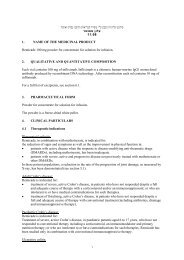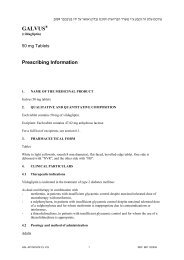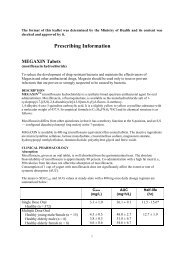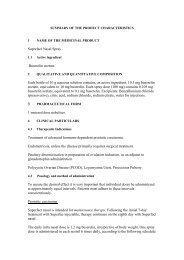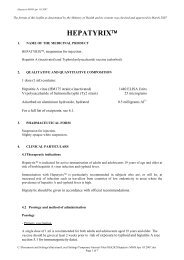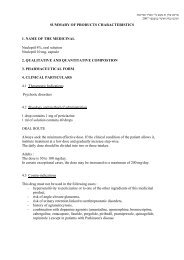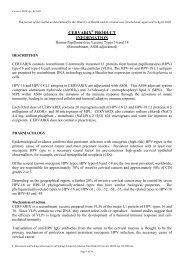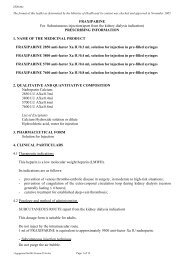SEBIVO®
SEBIVO®
SEBIVO®
You also want an ePaper? Increase the reach of your titles
YUMPU automatically turns print PDFs into web optimized ePapers that Google loves.
SEBIVO ®<br />
(telbivudine)<br />
600 mg tablets<br />
Prescribing Information<br />
. 2010 ינויב ודי לע רשואו קדבנ ונכותו תואירבה דרשמ י"<br />
ע עבקנ הז ןולע טמרופ<br />
1 Name of the medicinal product<br />
SEBIVO ® .<br />
2 Qualitative and quantitative composition<br />
Each film-coated tablet contains 600 mg telbivudine.<br />
For a full list of excipients, see section 6.1 List of excipients.<br />
3 Pharmaceutical form<br />
Film-coated tablet.<br />
SEB API JUN10 CL V3c REF BPI 070909
White to slightly yellowish-coloured, ovaloid-shaped, film-coated tablet, imprinted with<br />
“LDT” on one side.<br />
4 Clinical particulars<br />
4.1 Therapeutic indications<br />
Sebivo is indicated for the treatment of chronic hepatitis B in patients with evidence of viral<br />
replication and active liver inflammation in adults over 16 years of age.<br />
SEB API JUN10 CL V3c REF BPI 070909<br />
Page 2<br />
This indication is based on virological, serological, biochemical and histological responses in<br />
adult patients with HBeAg-positive and HBeAg-negative chronic hepatitis B.<br />
4.2 Posology and method of administration<br />
Therapy must be initiated by a physician experienced in the management of chronic hepatitis<br />
B infection in adults over 16 years of age.<br />
Adults<br />
The recommended dose of Sebivo for the treatment of chronic hepatitis B is 600 mg once<br />
daily, taken orally, with or without food.<br />
The optimal treatment duration has not been established. Treatment discontinuation should be<br />
considered as follows:<br />
• In HBeAg-positive patients, treatment should be administered at least until HBe<br />
seroconversion (HBeAg loss and HBV DNA loss with anti-HBe detection on two<br />
consecutive serum samples at least 3-6 months apart) or until HBs seroconversion or<br />
loss of efficacy.<br />
• In HBeAg-negative patients, treatment should be administered at least until HBs<br />
seroconversion or until there is evidence of loss of efficacy.<br />
Renal impairment/insufficiency<br />
Sebivo may be used for the treatment of chronic hepatitis B in patients with impaired renal<br />
function. No adjustment of the recommended dose of telbivudine is necessary in patients<br />
whose creatinine clearance is ≥50 mL/min. Dose adjustment is required in patients with<br />
creatinine clearance
Creatinine clearance (mL/min) Tablet Dose<br />
(1 tablet = 600 mg)<br />
30 – 49 600 mg once every 48 hours<br />
SEB API JUN10 CL V3c REF BPI 070909<br />
Page 4<br />
clinical and laboratory follow-up for at least 6 months in patients who discontinue antihepatitis<br />
B therapy. If appropriate, resumption of anti-hepatitis B therapy may be warranted.<br />
Lactic acidosis and severe hepatomegaly with steatosis, including fatal cases, have been<br />
reported with the use of nucleoside/nucleotide analogues alone or in combination with<br />
antiretrovirals. As telbivudine is a nucleoside analogue, this risk cannot be excluded.<br />
Treatment with nucleoside analogues should be discontinued when rapidly elevating<br />
aminotransferase levels, progressive hepatomegaly or metabolic/lactic acidosis of unknown<br />
aetiology occur. Benign digestive symptoms, such as nausea, vomiting and abdominal pain,<br />
may be indicative of lactic acidosis development. Severe cases, sometimes with fatal<br />
outcome, were associated with pancreatitis, liver failure/hepatic steatosis, renal failure and<br />
higher levels of serum lactate. Caution should be exercised when prescribing nucleoside<br />
analogues to any patient (particularly obese women) with hepatomegaly, hepatitis or other<br />
known risk factors for liver disease. These patients should be followed closely.<br />
Muscular effects<br />
Cases of myopathy and myalgia have been reported with telbivudine use several weeks to<br />
months after starting therapy. Myopathy has also been reported with some other drugs in this<br />
class. Isolated cases of rhabdomyolysis have been reported during post-marketing use of<br />
telbivudine (see section 4.8 Undesirable effects, Post marketing experience)<br />
Uncomplicated myalgia has been reported in telbivudine-treated patients (see section 4.8<br />
Undesirable effects). Myopathy, defined as persistent unexplained muscle aches and/or<br />
muscle weakness regardless of the degree of increases in creatine kinase (CK) levels, should<br />
be considered in any patient with unexplained diffuse myalgias, muscle tenderness or muscle<br />
weakness. Among patients with telbivudine-associated myopathy, there has not been a<br />
uniform pattern with regard to the degree or timing of CK elevations. In addition, the<br />
predisposing factors for the development of myopathy among telbivudine recipients are<br />
unknown. Patients should be advised to report promptly any persistent unexplained muscle<br />
aches, pain, tenderness or weakness. Telbivudine therapy should be discontinued if myopathy<br />
is diagnosed.<br />
It is not known if the risk of myopathy during treatment with drugs in this class is increased<br />
with concurrent administration of other drugs associated with myopathy (e.g. statins, fibrates,<br />
or ciclosporin). Physicians considering concomitant treatment with other agents associated<br />
with myopathy should weigh carefully the potential benefits and risks and should monitor<br />
patients for any signs or symptoms of unexplained muscle pain, tenderness, or weakness.<br />
An increased risk of developing peripheral neuropathy has been observed with the<br />
combination use of telbivudine and pegylated interferon alfa-2a (see section 4.5 Interaction<br />
with other medicinal products and other forms of interaction). The potential benefit of this<br />
combination therapy remains to be established.
SEB API JUN10 CL V3c REF BPI 070909<br />
Page 5<br />
Renal function<br />
Telbivudine is eliminated primarily by renal excretion, therefore dose adjustment is<br />
recommended in patients with creatinine clearance
SEB API JUN10 CL V3c REF BPI 070909<br />
Page 6<br />
decreased renal function due to concomitant disease or concomitant use of other medicinal<br />
products.<br />
Other Special populations<br />
Sebivo has not been investigated in co-infected hepatitis B patients (e.g. patients co-infected<br />
with HIV, HCV or HDV).<br />
Information for Patients<br />
Patients should be advised that treatment with Sebivo has not been shown to reduce the risk of<br />
transmission of HBV to others through sexual contact or blood contamination.<br />
4.5 Interaction with other medicinal products and other forms of<br />
interaction<br />
Since telbivudine is eliminated primarily by renal excretion, co-administration of Sebivo with<br />
substances that affect renal function (such as aminoglycosides, loop diuretics, platinum<br />
compounds, vancomycin, amphotericin B) may affect plasma concentrations of telbivudine<br />
and/or the co-administered substance.<br />
At concentrations up to 12 times that used in humans, telbivudine did not inhibit in vitro<br />
metabolism mediated by any of the following human hepatic microsomal cytochrome P450<br />
(CYP) isoenzymes known to be involved in human drug metabolism: 1A2, 2C9, 2C19, 2D26,<br />
2E1, and 3A4. Telbivudine does not induce cytochrome P450 isoenzymes in animals. Based<br />
on the above results and the known elimination pathway of telbivudine, the potential for<br />
CYP450-mediated interactions involving Sebivo with other medicinal products is low.<br />
The steady-state pharmacokinetics of telbivudine were unaltered following multiple dose<br />
administration in combination with lamivudine, adefovir dipivoxil, ciclosporin, pegylated<br />
interferon-alfa 2a or tenofovir disoproxil fumarate. In addition, telbivudine does not alter the<br />
pharmacokinetics of lamivudine, adefovir dipivoxil, ciclosporin or tenofovir disoproxil<br />
fumarate. No definitive conclusion could be drawn regarding the effects of telbivudine on the<br />
pharmacokinetics of pegylated interferon-alfa 2a due to the high inter-individual variability of<br />
pegylated interferon-alfa 2a concentrations (see section 4.4 Special warnings and precautions<br />
for use).<br />
A pilot clinical trial investigating the combination of telbivudine, 600 mg daily, with<br />
pegylated interferon alfa-2a, 180 micrograms once weekly by subcutaneous administration,<br />
indicates that this combination is associated with an increased risk of developing peripheral<br />
neuropathy (see section 4.4 Special warnings and precautions for use).
4.6 Pregnancy and lactation<br />
Pregnancy Category B<br />
SEB API JUN10 CL V3c REF BPI 070909<br />
Page 7<br />
For telbivudine no clinical data on exposed pregnancies are available. Animal studies do not<br />
indicate direct or indirect harmful effects with respect to pregnancy, embryonal/foetal<br />
development, parturition or postnatal development (see 5.3 Preclinical safety data). Sebivo<br />
should be used during pregnancy only if the benefit to the mother outweighs the potential risk<br />
to the foetus.<br />
There are no data on the effect of telbivudine on transmission of HBV from mother to infant.<br />
Therefore, appropriate interventions should be used to prevent neonatal acquisition of HBV<br />
infection.<br />
Women of child-bearing potential<br />
No special requirements.<br />
Lactation<br />
Telbivudine is excreted in the milk of rats. It is not known whether telbivudine is excreted in<br />
human milk. Women should not breast-feed if they are taking Sebivo.<br />
Fertility<br />
There are no clinical data on the effects of telbivudine on male or female fertility. In<br />
reproductive toxicology studies, fertility was slightly reduced when both male and female rats<br />
received telbivudine at systemic exposures greater than 2.5 times those achieved in humans at<br />
the therapeutic dose (see section 5.3 Preclinical safety data).<br />
4.7 Effects on ability to drive and use machines<br />
No specific recommendations.<br />
4.8 Undesirable effects<br />
Approximately 1,500 subjects have been treated with telbivudine in clinical studies at a dose<br />
of 600 mg once daily . Assessment of adverse reactions is primarily based on two studies (007<br />
GLOBE and NV-02B-015) in which 1,699 patients with chronic hepatitis B received doubleblind<br />
treatment with telbivudine 600 mg/day (n=847) or lamivudine (n=852) for 104 weeks.<br />
The safety profiles of telbivudine and lamivudine were generally comparable in these studies.<br />
In the 104 week clinical studies telbivudine was generally well tolerated, with most adverse<br />
experiences classified as mild or moderate in severity. In the 007 GLOBE and NV-02B-015<br />
studies patient discontinuations for adverse events, clinical disease progression or lack of<br />
efficacy were 1.5% for telbivudine and 4.1% for lamivudine.
SEB API JUN10 CL V3c REF BPI 070909<br />
Page 8<br />
Table 4-2 lists the adverse reactions recorded in the pooled 104 week 007 GLOBE and NV-<br />
02B015 studies by system organ class and by frequency using the following convention:<br />
common (≥1/100;
Table 4-3 Summary of ALT flares 1 by 6-month intervals in the pooled 007<br />
GLOBE and NV-02B-015 studies<br />
Telbivudine Lamivudine<br />
600 mg<br />
100 mg<br />
(n = 847)<br />
(n =852)<br />
Overall 4.8 % 7.9 %<br />
Baseline to week 24 3.0 % 2.9 %<br />
Week 24 to week 52 0.4 % 1.7 %<br />
Week 52 to week 76 0.7 % 2.0 %<br />
Week 76 to week 104 1.3 % 2.0 %<br />
Week 24 to end of treatment 2.0 % 5.3 %<br />
1 intermittent elevations of aminotransferase activity to >10x upper limit of normal and >2x baseline value<br />
SEB API JUN10 CL V3c REF BPI 070909<br />
Page 9<br />
Exacerbations of hepatitis B after discontinuation of treatment<br />
Severe acute exacerbations of hepatitis B have been reported in patients who have<br />
discontinued anti-hepatitis B therapy. There are insufficient data on post-treatment<br />
exacerbations of hepatitis B after discontinuation of telbivudine treatment (see section 4.4<br />
Special warnings and precautions for use).<br />
Post-marketing experience<br />
The following adverse drug reactions have been identified based on post-marketing<br />
spontaneous reports and are orgenized by system organ classes. Because these reactions are<br />
reported voluntarily from a population of uncertain size, it is not always possible to reliably<br />
estimate their frequency.<br />
Muscoloskeletal, connective tissue and bone disorders<br />
Rhabdomyolysis has been very rarely reported.<br />
4.9 Overdose<br />
No case of overdose with Sebivo has been reported. Tested doses up to 1,800 mg/day, three<br />
times greater than the recommended daily dose, have been well tolerated. A maximum<br />
tolerated dose of telbivudine has not been determined. In the event of an overdose, Sebivo<br />
should be discontinued and appropriate general supportive treatment applied as necessary.<br />
5 Pharmacological properties<br />
5.1 Pharmacodynamic properties<br />
Pharmacotherapeutic group: Antiviral for systemic use, ATC code: J05AF11.
Page 10<br />
Telbivudine is a synthetic thymidine nucleoside analogue with activity against HBV DNA<br />
polymerase. It is efficiently phosphorylated by cellular kinases to the active triphosphate<br />
form, which has an intracellular half-life of 14 hours. Telbivudine-5'-triphosphate inhibits<br />
HBV DNA polymerase (reverse transcriptase) by competing with the natural substrate,<br />
thymidine 5'-triphosphate. Incorporation of telbivudine-5'-triphosphate into viral DNA causes<br />
DNA chain termination, resulting in inhibition of HBV replication. Telbivudine is an inhibitor<br />
of both HBV first-strand (EC50 = 0.4-1.3 microM) and second-strand (EC50 = 0.12-0.24<br />
microM) synthesis, and shows a distinct preference for inhibiting second-strand production.<br />
By contrast, telbivudine-5'-triphosphate at concentrations up to 100 microM did not inhibit<br />
human cellular DNA polymerases alpha, beta, or gamma. In assays relating to human<br />
mitochondrial structure, function and DNA content, telbivudine lacked an appreciable toxic<br />
effect at concentrations up to 10 microM and did not increase lactic acid production in vitro.<br />
The in vitro antiviral activity of telbivudine was assessed in the HBV-expressing human<br />
hepatoma cell line 2.2.15, as well as in primary duck hepatocytes infected with duck hepatitis<br />
B virus (DHBV). The concentration of telbivudine that effectively inhibited 50% of viral<br />
synthesis (EC50) in both systems was approximately 0.2 microM. The antiviral activity of<br />
telbivudine is specific to hepatitis B virus and related hepadnaviruses. No activity was noted<br />
against multiple other RNA and DNA viruses, including human immunodeficiency virus<br />
(HIV) type 1 (EC50 value >200 microM). The absence of activity of telbivudine against HIV<br />
has not been evaluated in clinical trials.<br />
In 4- and 12-week studies of hepadnavirus-infected woodchucks (marmota monax), a relevant<br />
animal model for HBV, telbivudine significantly reduced viral DNA levels. Within 28 days,<br />
at oral doses of 10 mg/kg/day, serum viral DNA levels decreased by as much as 8 log10 to<br />
undetectable levels (
Page 11<br />
Clinical experience<br />
The safety and efficacy of long term (104 week) telbivudine treatment were evaluated in two<br />
active-controlled clinical studies that included 1,699 patients with chronic hepatitis B (007<br />
GLOBE and NV-02B015). All patients were 16 years of age or older, with chronic hepatitis<br />
B, evidence of HBV infection with viral replication (HBsAg-positive, HBeAg-positive or<br />
HBeAg-negative, HBV DNA detectable by PCR assay), elevated ALT levels ≥ 1.3 times the<br />
upper limit of normal (ULN), and chronic inflammation on liver biopsy compatible with<br />
chronic viral hepatitis.<br />
Study 007 “GLOBE”<br />
The 007 “GLOBE” study is a Phase III, randomised, double-blind, multinational study of<br />
telbivudine 600 mg once daily compared to lamivudine 100 mg once daily for a treatment<br />
period of up to 104 weeks in 1,367 nucleoside-naïve chronic hepatitis B HBeAg-positive and<br />
HBeAg-negative patients. The primary data analysis was conducted after all patients had<br />
reached week 52.<br />
HBeAg-positive patients: The mean age of patients was 32 years, 74% were male, 82% were<br />
Asian, 12% were Caucasian, and 6% had previously received alpha-interferon therapy. At<br />
baseline, patients had a mean Knodell Necroinflammatory Score ≥7, mean serum HBV DNA<br />
as measured by Roche COBAS Amplicor® PCR assay was 9.52 log10 copies/mL, and mean<br />
serum ALT was approximately 153 IU/litre. Pre- and post-liver biopsy samples were adequate<br />
for 86% of patients.<br />
HBeAg-negative patients: The mean age of patients was 43 years, 79% were male, 65% were<br />
Asian, 23% were Caucasian, and 11% had previously received alpha-interferon therapy. At<br />
baseline, patients had a mean Knodell Necroinflammatory Score ≥7, mean serum HBV DNA<br />
as measured by Roche COBAS Amplicor® PCR assay was 7.54 log10 copies/mL, and mean<br />
serum ALT was approximately 140 IU/litre. Pre- and post-liver biopsy samples were adequate<br />
for 92% of patients.<br />
Clinical results at week 52<br />
Clinical and virological efficacy endpoints were evaluated separately in the HBeAg-positive<br />
and HBeAg-negative patient populations in Study 007. The primary endpoint of therapeutic<br />
response at week 52 is a composite serological endpoint requiring suppression of HBV DNA<br />
to
Page 12<br />
Telbivudine showed a greater reduction than lamivudine in viral load as early as Week 12 in<br />
HBeAg-positive patients (p=0.0157) and Week 8 in HBeAg-negative patients (p=0.0242).<br />
Table 5-1 Virological, biochemical and serological endpoints at week 52 (007<br />
GLOBE study)<br />
Response parameter<br />
Mean HBV DNA<br />
reduction from baseline<br />
(log10<br />
copies/mL) ± SEM 1,2<br />
% Patients HBV DNA<br />
negative by PCR<br />
HBeAg-positive (n = 921) HBeAg-negative (n = 446)<br />
Telbivudine<br />
600 mg<br />
(n = 458)<br />
Lamivudine<br />
100 mg<br />
(n = 463)<br />
Telbivudine<br />
600 mg<br />
(n = 222)<br />
Lamivudine<br />
100 mg<br />
(n = 224)<br />
-6.45 (0.11) * -5.54 (0.11) -5.23 (0.13) * -4.40 (0.13)<br />
60%* 40% 88%* 71%<br />
ALT normalisation 3 77% 75% 74% 79%<br />
HBeAg seroconversion 4 23% 22% NA NA<br />
HBeAg loss 4 26% 23% NA NA<br />
1 Roche COBAS Amplicor ® PCR Assay (lower limit of quantification{LLOQ} ≤300 copies/mL)<br />
2 HBeAg-positive: n = 443 and 444, HBeAg-negative: n = 219 and 219, for both telbivudine and lamivudine<br />
groups, respectively. Difference in populations due to exclusion of observations after treatment discontinuation<br />
due to efficacy and initiation of non-study anti-HBV drugs<br />
3 HBeAg-positive: n = 440 and 446, HBeAg-negative: n = 203 and 207, for telbivudine and lamivudine groups,<br />
respectively. ALT normalisation assessed only in patients with ALT > ULN at baseline<br />
4 n = 432 and 442, for telbivudine and lamivudine groups, respectively. HBeAg seroconversion and loss<br />
assessed only in patients with detectable HBeAg at baseline<br />
*p
Page 13<br />
Table 5-2 Histological improvement and change in Ishak Fibrosis Score at week 52<br />
(007 GLOBE study)<br />
HBeAg-positive (n = 921) HBeAg-negative (n = 446)<br />
Telbivudine<br />
600 mg<br />
(n = 384) 1<br />
Lamivudine<br />
100 mg<br />
(n = 386) 1<br />
Telbivudine<br />
600 mg<br />
(n = 199) 1<br />
Lamivudine<br />
100 mg<br />
(n = 207) 1<br />
Histological response 2<br />
Improvement 71%* 61% 71% 70%<br />
No Improvement<br />
Ishak Fibrosis Score<br />
17% 24% 21% 24%<br />
3<br />
Improvement 42% 47% 49% 45%<br />
No change 39% 32% 34% 43%<br />
Worsening 8% 7% 9% 5%<br />
Missing week 52 biopsy 12% 15% 9% 7%<br />
1<br />
Patients with ≥ one dose of study drug with evaluable baseline liver biopsies and baseline Knodell Histological Activity<br />
Index (HAI) score >3<br />
2<br />
Histological response defined as ≥2 point decrease in Knodell Necroinflammatory Score from baseline with no worsening<br />
of the Knodell Fibrosis Score<br />
3<br />
For Ishak Fibrosis Score, improvement defined as a ≥1 point reduction in Ishak Fibrosis Score from baseline to week 52<br />
*p = 0.0024<br />
Clinical results at Week 104<br />
Overall, clinical results at Week 104 in telbivudine-treated patients were consistent with those<br />
at Week 52, demonstrating durability of efficacy responses for telbivudine-treated patients<br />
with continued treatment.<br />
Among HBeAg-positive patients, Therapeutic Response (63% vs 48%; p
Page 14<br />
Patients who achieved non-detectable HBV DNA levels and/or normalized ALT at 24 weeks<br />
were more likely to undergo e-antigen seroconversion, achieve undetectable levels of HBV<br />
DNA, normalize ALT, and minimize resistance at one and two years.<br />
Study NV-02B-015<br />
NV-02B-015 is a Phase III, randomized, double-blind, study of telbivudine 600 mg once<br />
daily compared to lamivudine 100 mg once daily for a treatment period of 104 weeks in 332<br />
nucleoside-naïve chronic hepatitis B HBeAg-positive and HBeAg-negative Chinese patients.<br />
The primary efficacy endpoint was serum HBV DNA reduction at Week 52, defined as the<br />
reduction (in log10 copies/mL) in serum HBV DNA levels from baseline values. Therapeutic<br />
Response was a key secondary endpoint.<br />
Selected virological, biochemical and serological outcome measures are shown in Table 5-3.<br />
Efficacy results from study NV-02B-015 are consistent with the 007 GLOBE study results at<br />
week 52 and 104.<br />
NV-02B-015 - Outcomes at Week 52<br />
Table 5-3 Virological, Biochemical and Serologic Endpoints and Therapeutic<br />
Response at Week 52 (NV-02B-015)<br />
Response Parameter<br />
Mean HBV DNA Reduction from<br />
Baseline (log10 copies/mL) ± SEM 1<br />
% Subjects HBV DNA Negative by<br />
PCR<br />
HBeAg-positive (n= 290) HBeAg-negative (n=42 )<br />
Telbivudine<br />
600 mg<br />
(n=147)<br />
Lamivudine<br />
100 mg<br />
(n=143)<br />
Telbivudine<br />
600 mg<br />
(n=20)<br />
Lamivudine<br />
100 mg<br />
(n=22)<br />
-6.33 (0.18) -5.49 (0.18) -5.49 (0.40) -4.81 (0.38)<br />
67%* 38% 85% 77%<br />
ALT Normalization 2 87% 75% 100% 78%<br />
HBeAg Seroconversion 3 25% 18% NA NA<br />
HBeAg Loss 3 31% 20% NA NA<br />
Therapeutic Response 85%* 62% 100% 82%<br />
1 Roche COBAS Amplicor® Assay (LLOQ≤300 copies/mL)<br />
2 n=142 and 135, for telbivudine and lamivudine groups, respectively. ALT normalization assessed only in subjects with<br />
ALT > ULN at baseline<br />
3 n = 138 for both telbivudine and lamivudine groups. HBeAg seroconversion and loss assessed only in subjects with<br />
detectable HBeAg at baseline<br />
* p
Page 15<br />
Although the number of HBeAg-negative subjects in this study is small (n=42), results for<br />
key endpoints remain consistent for telbivudine at Week 104 (therapeutic response: 90% vs<br />
68%, mean log10 HBV DNA reduction: -5.59 vs -4.20, PCR negativity: 90% vs 68%, and<br />
ALT normalization: 95% vs 78%).<br />
Study NV-02B-018<br />
NV-02B-018 is a Phase IIIb, randomized, open-label, multi-center study of treatment with<br />
telbivudine 600 mg once daily compared to adefovir dipivoxil 10 mg once daily for a<br />
treatment period of 52 weeks in 135 adult subjects with HBeAg-positive compensated<br />
chronic hepatitis B. The primary endpoint was serum HBV DNA reduction from baseline at<br />
Week 24 with a secondary comparison at Week 52.<br />
In study NV-02B-018, the mean age of subjects was 32 years, 76% were male, 92% were<br />
Asian, 4% were Caucasian, and 1% had previously received alfa-interferon therapy. At<br />
baseline, 95 % of subjects were diagnosed with Chronic hepatitis B ≥ 9 years ago, mean<br />
serum HBV DNA as measured by Roche COBAS Amplicor ® PCR assay was 9.67 log10<br />
copies/mL, and mean serum ALT was 173 IU/L.<br />
At Week 24, the mean reduction of serum HBV DNA from baseline was -6.29 vs -4.92 log10<br />
copies/mL for telbivudine (n= 45) and adefovir dipivoxil (n=90), respectively.<br />
Clinical resistance<br />
In the Phase III global registration trial (007 GLOBE study), 55.7% (255/458) of treatmentnaïve<br />
HBeAg-positive and 82.0% (182/222) of treatment-naïve HBeAg-negative patients<br />
receiving telbivudine 600 mg once daily achieved nondetectable serum HBV DNA levels<br />
(300 copies/ml and elevation of serum ALT.<br />
Cross-resistance<br />
Cross-resistance has been observed among HBV nucleoside analogues. In cell-based assays,<br />
lamivudine-resistant HBV strains containing either the rtM204I mutation or the<br />
rtL180M/rtM204V double mutation had ≥1,000-fold reduced susceptibility to telbivudine.<br />
HBV encoding the adefovir resistance-associated substitutions at rtN236T and A181V had<br />
0.5- and 1.0- fold change in susceptibility to telbivudine in cell culture, respectively.<br />
Substitution at rtA194T had 0.99-fold shift in susceptibility to telbivudine in cell culture<br />
SEB API JUN10 CL V3c REF BPI 070909
Page 16<br />
ALT Flares<br />
In the 007 GLOBE study, the incidence of alanine aminotransferase (ALT) flares was similar<br />
in the telbivudine and lamivudine treatment arms in the first six months of treatment, but was<br />
lower for telbivudine after week 24 (see section 4.8 Undesirable effects, Table 4-3).<br />
Cardiac safety<br />
There is no evidence of cardiotoxicity for telbivudine. In an in vitro hERG model, telbivudine<br />
was negative at concentrations up to 10,000 microM. In a thorough QTc prolongation clinical<br />
study in healthy subjects, telbivudine had no effect on QT intervals or other<br />
electrocardiographic parameters after multiple daily doses up to 1,800 mg.<br />
5.2 Pharmacokinetic properties<br />
The single- and multiple-dose pharmacokinetics of telbivudine were evaluated in healthy<br />
subjects and in patients with chronic hepatitis B. Sebivo pharmacokinetics are similar<br />
between both populations.<br />
Absorption and Bioavailability<br />
Following oral administration of telbivudine 600 mg once daily in healthy subjects (n =12),<br />
steady state peak plasma concentration (Cmax) was 3.69 ± 1.25 micrograms /mL (mean ± SD)<br />
which occurred between 1 and 4 hours (median 2 hours), AUC was 26.1 ± 7.2 micrograms<br />
·h/mL (mean ± SD), And trough plasma concentrations (Ctrough) were approximately 0.2-0.3<br />
micrograms/mL. Steady state was achieved after approximately 5 to 7 days of once-daily<br />
administration with ~1.5-fold accumulation, suggesting an effective half-life of ~15 hours.<br />
Effect of food on oral absorption<br />
Telbivudine absorption and exposure were unaffected when a single 600 mg dose was<br />
administered with food.<br />
Distribution<br />
In vitro binding of telbivudine to human plasma proteins is low (3.3%). After oral dosing, the<br />
estimated apparent volume of distribution is in excess of total body water, suggesting that<br />
telbivudine is widely distributed into tissues. Telbivudine was equally partitioned between<br />
plasma and blood cells.<br />
Biotransformation<br />
No metabolites of telbivudine were detected following administration of 14 C-telbivudine in<br />
humans. Telbivudine is not a substrate, inhibitor or inducer of the cytochrome P450<br />
(CYP450) enzyme system (see section 4.5 Interaction with other medicinal products and other<br />
forms of interaction).<br />
SEB API JUN10 CL V3c REF BPI 070909
Elimination<br />
Page 17<br />
After reaching peak concentration, plasma concentrations of telbivudine declined in a biexponential<br />
manner with a terminal elimination half-life (t1/2) of 40-49 hours. Telbivudine is<br />
eliminated primarily by urinary excretion of unchanged drug. The renal clearance of<br />
telbivudine approaches normal glomerular filtration rate, suggesting that passive diffusion is<br />
the main mechanism of excretion. Approximately 42% of the dose is recovered in the urine<br />
over 7 days following a single 600 mg oral dose of telbivudine. Because renal excretion is the<br />
predominant route of elimination, patients with moderate to severe renal dysfunction and<br />
those undergoing haemodialysis require a dose adjustment (see section 4.2 Posology and<br />
method of administration).<br />
Characteristics in patients<br />
Gender<br />
There are no significant gender-related differences in telbivudine pharmacokinetics.<br />
Race<br />
There are no significant race-related differences in telbivudine pharmacokinetics.<br />
Paediatrics and geriatrics<br />
Pharmacokinetic studies have not been conducted in paediatric or elderly subjects.<br />
Renal impairment<br />
The single-dose pharmacokinetics of telbivudine have been evaluated in patients (without<br />
chronic hepatitis B) with various degrees of renal impairment (as assessed by creatinine<br />
clearance). Based on the results shown in Table 5-4, adjustment of the dose for telbivudine is<br />
recommended in patients with creatinine clearance of
Page 18<br />
Table 5-4 Pharmacokinetic parameters (mean ± SD) of telbivudine in subjects<br />
with various degrees of renal function<br />
Renal function (creatinine clearance in mL/min)<br />
Normal (>80) Mild (50–80) Moderate (30–49) Severe (
Page 19<br />
exposures approximately 14 times those achieved in humans at the therapeutic dose) and<br />
mated with untreated rats.<br />
A separate study indicated reduced fertility when both male and female rats were treated with<br />
telbivudine doses of 500 or 1000 mg/kg/day. A lower fertility index was noted in pairs given<br />
500 (76%) or 1000 (72%) mg/kg/day when compared to concurrent controls (92%). There<br />
were no abnormalities in sperm morphology or function, and the testes and ovaries were<br />
histologically unremarkable.<br />
Fertility was assessed as part of a juvenile toxicology study in which rats treated from Day 14<br />
to Day 70 were mated with rats from other litters receiving the same treatment. The mean<br />
number of days to mating was slightly higher at 1000 and 2000 mg/kg/day. The fertility<br />
indices were reduced at 1000 mg/kg (40%) and 2000 mg/kg/day (50%) compared to the 80%<br />
value in the control group. In this study, the mating index and conception rate were slightly<br />
reduced, however the ovarian and uterine parameters of those females mating successfully<br />
were unaffected by administration of telbivudine. There was no effect on fertility or mating<br />
parameters at 250 mg/kg/day where the exposure was 2.5 to 2.8 times higher than exposure<br />
achieved in humans at the therapeutic dose.<br />
Telbivudine is not teratogenic and has shown no adverse effects in developing embryos and<br />
foetuses in preclinical studies. Studies in pregnant rats and rabbits showed that telbivudine<br />
crosses the placenta. Developmental toxicity studies revealed no evidence of harm to the<br />
foetus in rats and rabbits at doses up to 1,000 mg/kg/day, providing exposure levels 6- to 37times<br />
higher, respectively, than those observed with the therapeutic dose (600 mg/day) in<br />
humans.<br />
Cardiac safety<br />
There is no evidence of cardiotoxicity for telbivudine. In an in vitro hERG model, telbivudine<br />
was negative at concentrations up to 10,000 microM.<br />
6 Pharmaceutical particulars<br />
6.1 List of excipients<br />
Tablet core<br />
Cellulose microcrystalline<br />
Povidone<br />
Sodium starch glycolate<br />
Magnesium stearate<br />
Silica, colloidal anhydrous<br />
SEB API JUN10 CL V3c REF BPI 070909
Tablet film coat<br />
Titanium dioxide (E171)<br />
Macrogol 4000<br />
Talc<br />
Hypromellose<br />
6.2 Incompatibilities<br />
Not applicable.<br />
6.3 Special precautions for storage<br />
Store in the original package under 30°c.<br />
Sebivo must be kept out of the reach and sight of children.<br />
6.4 Nature and contents of container<br />
PVC/aluminium blisters. Pack size: 28 film-coated tablets<br />
6.5 Special precautions for disposal<br />
No special requirements.<br />
Manufacturer:<br />
Novartis Pharma Stein AG<br />
Schaffhauserstrasse<br />
CH-4332 Stein<br />
Switzerland<br />
License Holder:<br />
Novartis Pharma Services AG,<br />
36 Shacham St.<br />
Petach-Tikva<br />
Israel<br />
Page 20<br />
SEB API JUN10 CL V3c REF BPI 070909




